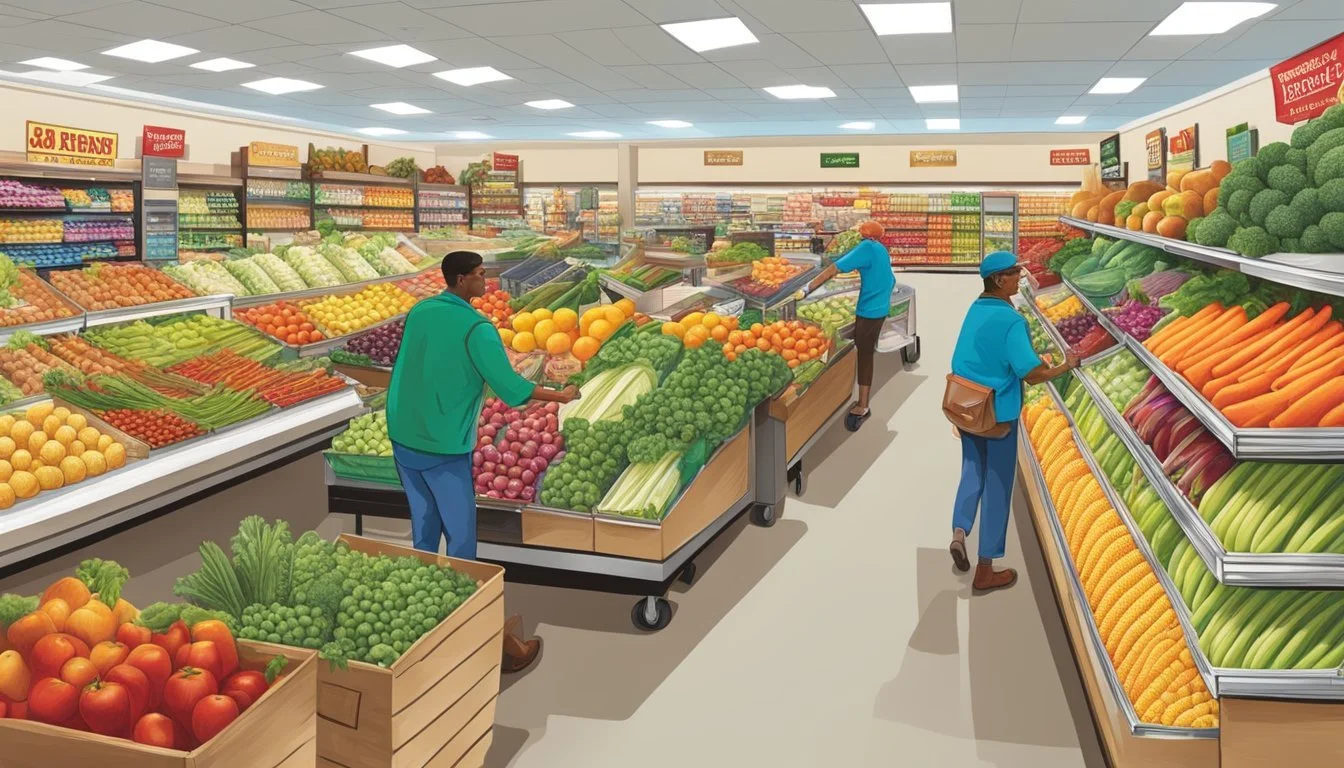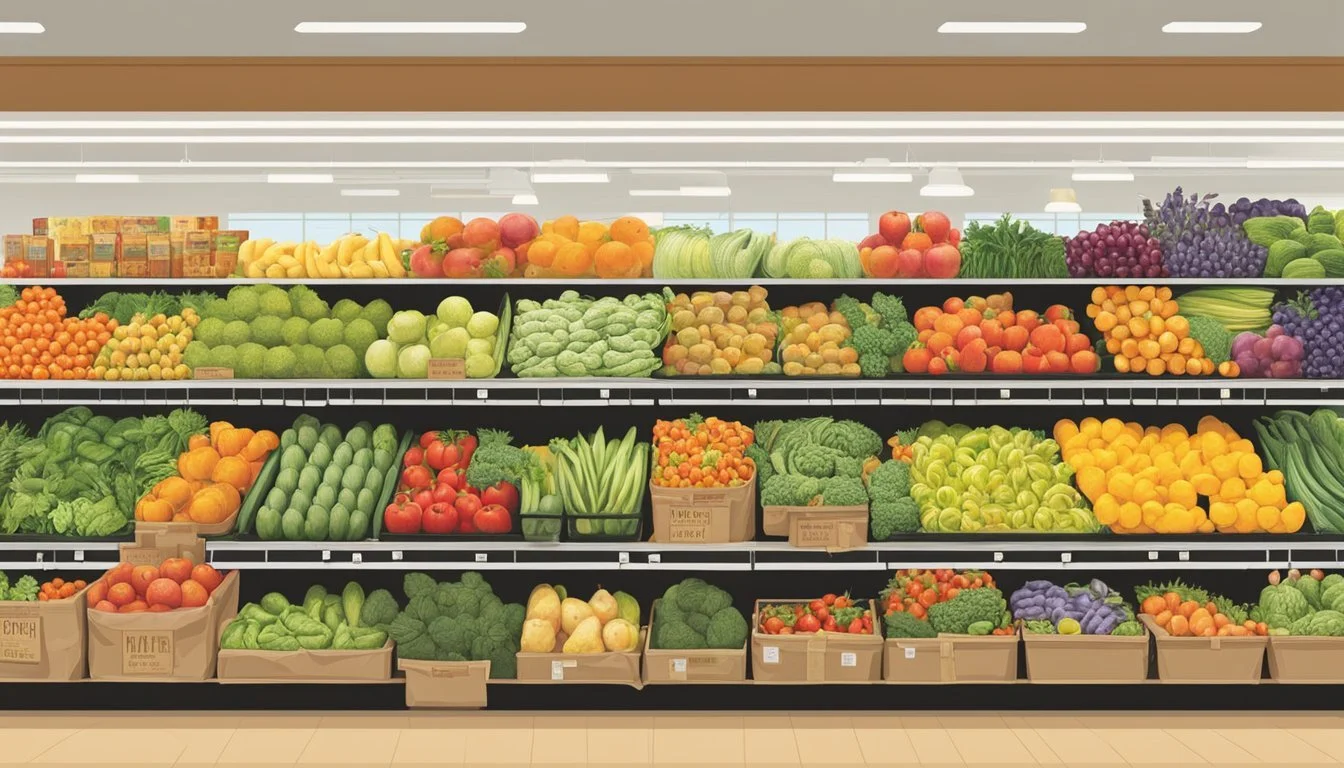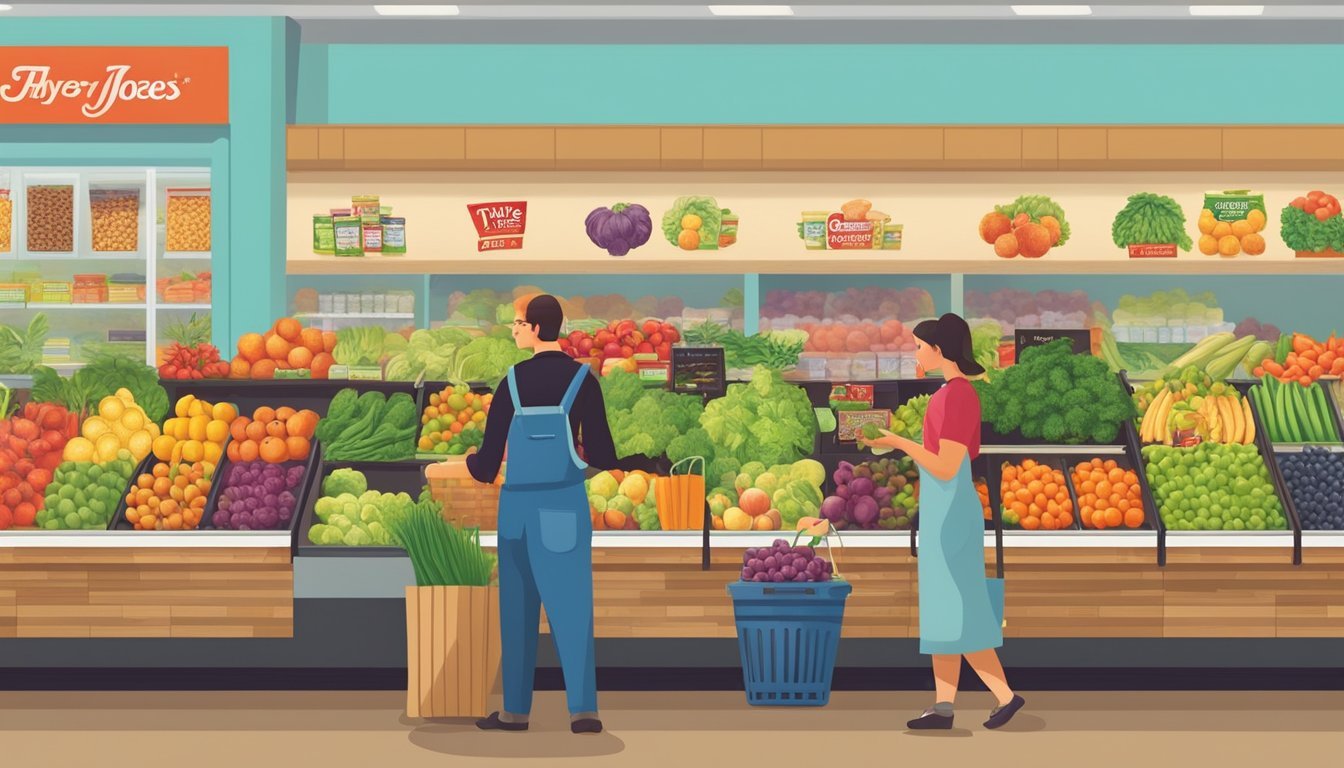Trader Joe's vs Hy-Vee
Comparing Selection, Prices, and Shopper Experience
Part of Our Grocery Store Guide with Details on Trader Joe's and Hy-Vee
Choosing the right grocery store is a critical decision for consumers in the U.S. who value both quality and affordability. Trader Joe's and Hy-Vee are two supermarkets with distinct qualities that cater to different preferences and needs. Trader Joe's, with its competitive pricing and a wide array of private-label products, positions itself as an accessible option for gourmet food lovers. They are recognized for offering a variety of specialty items such as affordable fancy cheeses and wine, which appeal to the budget-conscious foodie.
On the other hand, Hy-Vee distinguishes itself with a more traditional supermarket experience, tailored to offer a broad range of goods from fresh produce to pharmacy services across the Midwest and Southern United States. Providing a one-stop-shop experience, Hy-Vee focuses on customer service and convenience, featuring amenities like in-store delis and bakeries, which contribute to its reputation as a trusted grocery retailer. Both supermarkets have committed customer bases and philosophies that drive their operations, aiming to deliver quality and convenience to America's diverse array of grocery shoppers.
History and Background
Analyzing the timeline and expansion of Trader Joe's and Hy-Vee illuminates the evolution of these supermarket chains and their standing in the market.
Founding and Growth
Trader Joe’s was established in 1967 by Joe Coulombe in Pasadena, California. It began as a small chain of convenience stores under the name Pronto Markets. In 1967, the stores were rebranded to Trader Joe's and the company started to reinvent itself by introducing innovative, hard-to-find, and great-tasting foods. The first store branded as Trader Joe’s opened its doors with a nautical theme that has since become emblematic of the chain. In 1979, Theo Albrecht, the owner of Aldi Nord, acquired Trader Joe’s which has grown to operate over 500 stores across the United States.
Hy-Vee, on the other hand, has its roots in a small general store in Beaconsfield, Iowa, founded in 1930 by Charles Hyde and David Vredenburg. The store's name, Hy-Vee, is a contraction of its founders' last names. Unlike Trader Joe's, Hy-Vee has remained a family-owned chain. Over time, it has grown to become one of the largest independently owned supermarket chains in the Midwest with over 240 locations spread across the region.
Market Position and Presence
Trader Joe’s has a strong market presence as a national chain known for its unique store brand products and competitive pricing. It has cultivated a loyal customer base with its curated selection of goods, often organic and non-GMO offerings. Its reputation for affordable prices and distinctive products, including international food items, has solidified its standing in the supermarket industry.
Hy-Vee has a significant regional presence in the Midwest, characterized by larger stores and a wider variety of products, including full-service restaurants, pharmacies, and health clinics in some locations. Hy-Vee is known for its customer service and community involvement, positioning itself as a one-stop shop for groceries, health, and wellness needs. Both chains have maintained a focus on quality and value, but they differ significantly in their store formats and regional footprints.
Store Brand and Product Quality
When comparing Trader Joe's and Hy-Vee, a discerning look at their store brands and the quality of their fresh produce and meats is essential to understand which grocery store stands out.
Exclusive Brands Comparison
Trader Joe's is renowned for its unique store brands, which often earn acclaim for their quality and value. Notably, the grocery chain's store-brand products equal those of private-brand leaders like Costco in customer scores. On the other hand, Hy-Vee offers a variety of store brands, such as their Hy-Vee products that compete closely with national brands both in terms of price and quality, with some products considered to be on par with or even superior to their name-brand counterparts.
Trader Joe's
Product Range: Wide, tailored to the brand's unique image.
Customer Perceptions: High-quality, competitively priced.
Hy-Vee
Product Range: Diverse, with an emphasis on matching national brand quality.
Customer Perceptions: Good value for money, satisfying quality.
Quality of Produce and Meat
Both Trader Joe's and Hy-Vee provide high-quality produce and meats, a crucial aspect of their offerings that heavily influence shopper preference.
Produce:
Trader Joe's: Known for a carefully selected range of high-quality produce that resonates with its customers.
Hy-Vee: Prioritizes freshness and quality, offering a broad selection of fruits and vegetables that meet a high standard.
Meat:
Trader Joe's: Offers a variety of meat options; however, some shoppers find the range less extensive than traditional supermarkets.
Hy-Vee: Provides a wide assortment of meat and seafood recognized for quality, often sourced from local producers when possible.
Price Comparison
When choosing between Trader Joe's and Hy-Vee, shoppers often consider pricing as a critical factor. This section delves into the stores' pricing strategies and the types of discounts they offer, allowing customers to understand where they might find better value for their money.
Everyday Pricing Strategies
Trader Joe's is known for its competitive everyday prices, mainly due to its private label approach. They offer a wide array of products under their own branding, which typically allows them to keep prices lower than standard retail brands. For example, a carton of almond milk or a bag of quinoa at Trader Joe’s might be priced significantly less than a branded equivalent at other stores.
On the other hand, Hy-Vee operates with a different pricing strategy. Hy-Vee tends to offer a larger selection of national brands and a variety of products, often resulting in a diverse price range. Shoppers may find both premium and budget items. Hy-Vee’s prices for staple items, such as dairy or produce, are competitive but may be higher on certain branded products compared to Trader Joe's.
Discounts and Deals Offered
Trader Joe's typically does not offer weekly sales, coupons, or promotions like traditional grocery stores. Instead, they maintain a low-price model throughout the year. However, shoppers may find occasional markdowns on seasonal or overstocked items.
Contrastly, Hy-Vee is known for offering various discounts and deals, including weekly ads with sale prices, fuel saver rewards, and the Hy-Vee Plus premium membership, which provides exclusive savings and offers like free delivery. Additionally, Hy-Vee regularly features loss leaders - products sold at or below cost to draw customers into the store in hopes they will purchase more items at regular prices.
It's important to note that Trader Joe's lack of traditional sales does not necessarily mean less savings. Their everyday low pricing can often offset the absence of special deals. Conversely, Hy-Vee's varied discount programs might appeal to shoppers who enjoy seeking out bargains and capitalizing on sales events.
Customer Experience and Service
When evaluating Trader Joe's and Hy-Vee, one finds that both brands emphasize customer experience, as evidenced by their store service and operations strategies. They understand that the shopping experience is as vital as product offerings.
Store Layout and Cleanliness
Trader Joe's maintains a distinctive store layout that prioritizes simplicity and convenience, contributing positively to consumer experiences. They are renowned for their unique offerings and a no-frills shopping environment that enables customers to navigate stores with ease. Surveys indicate that cleanliness is a standout feature, a testament to their commitment to creating a welcoming shopping atmosphere.
Hy-Vee, on the other hand, focuses on a more traditional supermarket layout, offering a wider variety of products and services. Hy-Vee stores are generally well-maintained and organized, ensuring customers enjoy a clean and orderly shopping experience. Both brands understand that an uncluttered and hygienic environment is fundamental to customer satisfaction.
Checkout Efficiency
At Trader Joe's, the checkout process is part of their customer service excellence, with rapid functionality acting as a cornerstone of their operations. The investment in a seamless checkout experience is evident in customer surveys, where they often receive high marks for efficiency.
Hy-Vee, while providing a conventional checkout experience, also incorporates technology and staffing solutions to reduce wait times. Customers at Hy-Vee can expect attentive service at the checkout lines, with employees focused on maintaining efficiency without sacrificing personable interactions.
Both Trader Joe's and Hy-Vee are competitive in their checkout operations—each in their way optimizes the process, ensuring customers conclude their shopping trip on a positive note.
Convenience and Location
When comparing Trader Joe's and Hy-Vee, considerations of convenience and location are critical for consumers. Each chain offers distinct accessibility options and grocery delivery solutions.
Store Accessibility
Trader Joe's operates numerous stores nationwide, often situated in urban and suburban areas for easy commuter access. These locations are typically sized for quick shopping experiences, appealing to individuals and small families prioritizing efficiency.
Hy-Vee, on the other hand, presents a broader retail footprint in the Midwest with some expansion into the South. These stores are larger, often providing a more extensive selection and one-stop shopping for customers.
Grocery Delivery Options
Trader Joe's has traditionally limited its grocery delivery options. However, in select locations where demand is high, customers may find third-party services that offer delivery for Trader Joe's products.
Hy-Vee has expanded its delivery capabilities, offering direct services through its own platform. Strategically, Hy-Vee partners with well-known programs like Amazon Prime to enhance convenience for its customers. This integration affords the consumer a familiar and seamless online shopping experience, with the added benefit of same-day delivery in certain areas.
Comparison with Competitors
In the competitive landscape of grocery stores, Trader Joe’s and Hy-Vee present distinct offerings and market strategies. Their performance varies across aspects such as pricing, product quality, customer perception, and market rankings.
Market Basket Analysis
The market basket analysis compares the pricing and product assortment of Trader Joe's with its competitors. Trader Joe’s is unique in its approach, offering a variety of private label products that typically allow for competitive pricing, setting it apart from Hy-Vee and others like Walmart and Kroger, known for their broader brand selection. For instance, Walmart’s strategy offers an expansive array of products at lower prices, with pricing on groceries averaging around 20 percent less than the combined average of surveyed stores. Similarly, Costco is celebrated for its bulk offerings, like the trademark $5 rotisserie chicken. Hy-Vee, on the other hand, differentiates itself with a focus on customer experience and a wide range of specialty and organic products.
Perception and Rankings
Customer perception and rankings highlight how shoppers view and prioritize their choice of grocery stores. Market research indicates that Trader Joe's often receives favorable outcomes for its product quality and value, outperforming competitors like Hy-Vee in these areas. In contrast, supermarkets like Publix and H-E-B earn recognition for their customer service and store cleanliness. While Whole Foods, now under the Amazon umbrella, is often associated with high-quality organic and natural products, it also comes with a higher price point. Researchers and consumer surveys have continually placed Trader Joe's at the top of several lists, suggesting strong customer loyalty and satisfaction.
This section compared Trader Joe's and Hy-Vee with competitors, focusing on market basket analysis and perception and rankings.
Consumer Insights
In comparing Trader Joe's and Hy-Vee, consumer demographics and shopping behaviors, along with satisfaction and loyalty metrics, are crucial for understanding their market strengths and customer preferences.
Demographics and Shopping Behaviors
Trader Joe's typically attracts a consumer base that values organic produce and healthy food options. Their customers often consist of individuals and families looking for unique and international food selections. The store experience is characterized by its smaller, more navigable layout, which appeals to shoppers who prefer an efficient, curated selection, often in urban or metropolitan areas.
In contrast, Hy-Vee serves a diverse demographic that includes families and individuals interested in a one-stop shopping experience. Their larger stores offer an extensive variety of products, including prepared foods and a vast selection of conventional and organic produce. They provide a more traditional supermarket experience, which is complemented by their online shopping and delivery services, attracting a mix of both tech-savvy consumers and those who prefer in-store shopping in the Midwest region.
Satisfaction and Loyalty Metrics
Customer satisfaction with Trader Joe's is generally high. They are known for their friendly staff and the overall quality of their products, especially private-label offerings. These factors contribute to a strong sense of loyalty among their clientele who appreciate the store's consistent quality and value.
Hy-Vee, on the other hand, garners high satisfaction rates due to its customer service and the ability to cater to various shopping preferences. It is recognized for its prepared foods section and the amenities it provides, which bolsters customer loyalty. The store invests in community relationships, and its commitment to customer service is evident in the positive feedback from its shoppers.
Future Trends and Predictions
As grocery chains adapt to changing markets, Trader Joe's and Hy-Vee are honing in on consumer preferences and industry innovations. The focus is on a variety of offerings tailored to emerging trends.
Evolving Consumer Preferences
Consumers increasingly seek convenience, quality, and unique product selections. Trader Joe's caters to these preferences with an assortment of exclusive, often gourmet, products. Their strategy is to provide a shopping experience that combines novelty with a friendly atmosphere. Meanwhile, Hy-Vee tends to center its approach around community presence and local preferences, aiming to offer a tailored shopping experience that resonates with the regional consumer base.
Industry Innovations
Innovation in the grocery industry is continuously evolving, with companies adopting new technologies and methodologies to stay ahead. Trader Joe’s is speculated to adopt further innovations to enhance its customer experience, likely embracing both in-store and virtual advancements without compromising on its unique store culture. On the other hand, Hy-Vee is recognized for its responsiveness to industry trends, particularly its adaptation of technology for convenience like online ordering and curbside pickup.
The paths these grocery chains are taking point to a broader industry trend: a blend of personalized in-store experience with digital convenience to satisfy the modern shopper’s desire for efficiency and variety.







